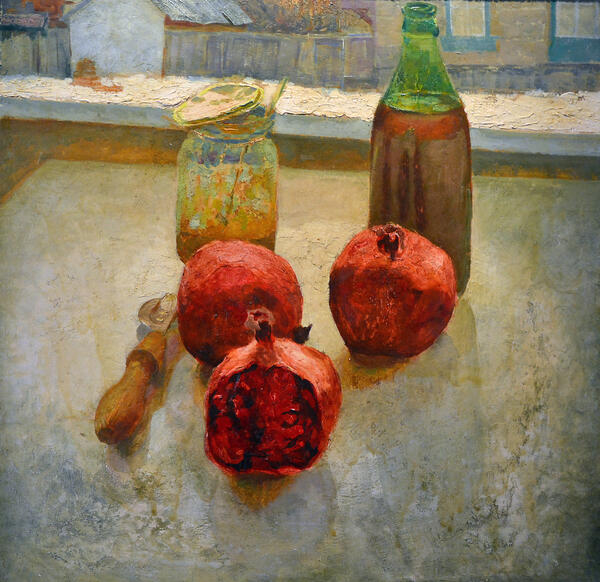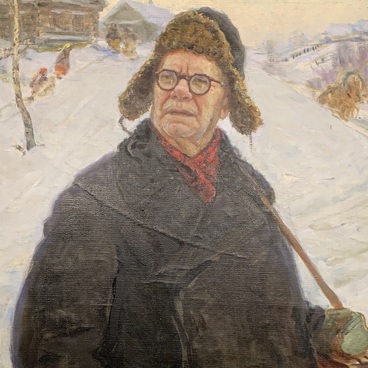Since the 1970s, Mordovian artists have been searching for the type of beauty that is consonant with their time and a new worldview. This is clearly evident in still lifes. They cease to be elegant in the traditional sense. Instead, they depict branches, thorns, and everyday objects which also have a special charm to the painters. This fully applies to the still life by Marat Semenovich Shanin (1928–2012), a People’s Artist of the Republic of Mordovia and the founder of the Shanin dynasty of artists. Thus, in the “Still Life with Pomegranates” (1975), we can see several pomegranate fruits, a can opener, a green bottle with brown liquid and a jar with a tin lid that has been opened.
Marat Shanin graduated from the Penza Art College in 1948. He studied under Ivan Goryushkin-Sorokopudov, a friend of the first professional artist of Mordovia Fedot Sychkov. After that, the young man continued his education at the Kharkiv State Art Institute. In 1955, together with his wife Lyubov Shanina-Trembachevskaya, he came to Mordovia.
The artist’s works are kept in the Kharkiv Art Museum, the Belarusian State Art Museum, the Konstantin Savitsky Regional Art Gallery in Penza, as well as in private collections in Russia and abroad, which indicates the artistic value of Marat Shanin’s paintings.
The “Still Life with Pomegranates” testifies to the artist’s unique talent for creating a cohesive image out of disparate elements. An experienced draughtsman and a skilled colorist, Marat Shanin uses an unusual technique of applying levkas — thin layers of a special mixture which is made of chalk, animal glue and vegetable oil. This is mainly an icon painting technique. In still lifes and others paintings, it helps to create a sense of volume due to the reflection of light.
The work is also notable in terms of its genre: this is a still life depicted in an interior setting against the backdrop of a landscape. The work is distinguished by the finest rendering of reflections and textures of objects, a clear and thought-out composition, and a harmonious arrangement of color accents. The artist seems to be setting up an experiment, trying to unravel the secret of how a masterpiece is created.
Marat Shanin graduated from the Penza Art College in 1948. He studied under Ivan Goryushkin-Sorokopudov, a friend of the first professional artist of Mordovia Fedot Sychkov. After that, the young man continued his education at the Kharkiv State Art Institute. In 1955, together with his wife Lyubov Shanina-Trembachevskaya, he came to Mordovia.
The artist’s works are kept in the Kharkiv Art Museum, the Belarusian State Art Museum, the Konstantin Savitsky Regional Art Gallery in Penza, as well as in private collections in Russia and abroad, which indicates the artistic value of Marat Shanin’s paintings.
The “Still Life with Pomegranates” testifies to the artist’s unique talent for creating a cohesive image out of disparate elements. An experienced draughtsman and a skilled colorist, Marat Shanin uses an unusual technique of applying levkas — thin layers of a special mixture which is made of chalk, animal glue and vegetable oil. This is mainly an icon painting technique. In still lifes and others paintings, it helps to create a sense of volume due to the reflection of light.
The work is also notable in terms of its genre: this is a still life depicted in an interior setting against the backdrop of a landscape. The work is distinguished by the finest rendering of reflections and textures of objects, a clear and thought-out composition, and a harmonious arrangement of color accents. The artist seems to be setting up an experiment, trying to unravel the secret of how a masterpiece is created.




